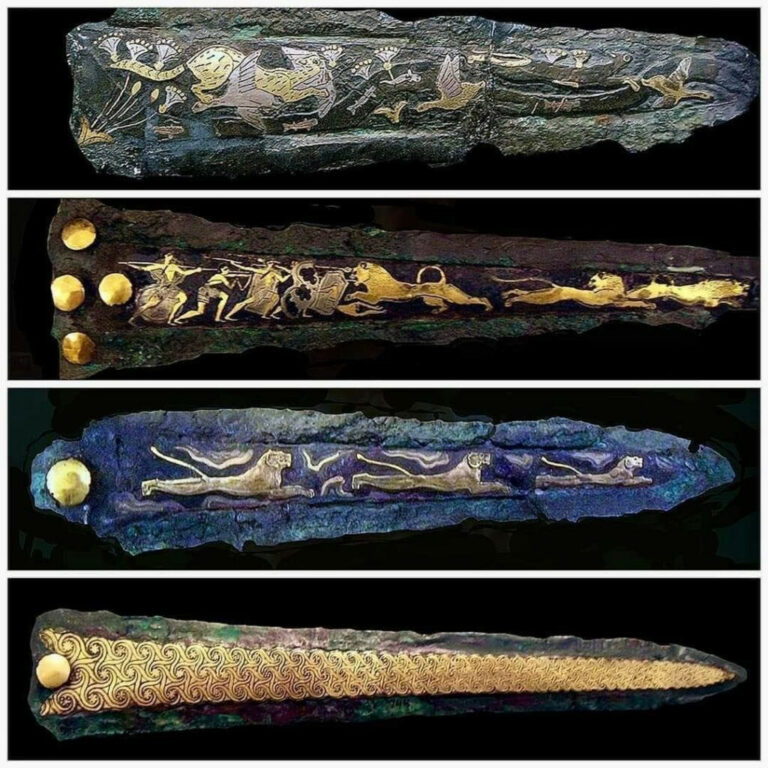Introduction
In the sun-drenched lands of mainland Greece, a civilization rose to prominence between 1750 and 1050 BC, leaving an indelible mark on history. The Mycenaeans, with their grand palaces, bustling urban centers, and sophisticated culture, laid the foundation for what would become the cradle of Western civilization. Among their many achievements, one particular artifact stands out as a testament to their ingenuity and craftsmanship – the Mycenaean bronze dagger.
These exquisite weapons, forged from bronze and adorned with intricate designs, have captivated scholars and enthusiasts alike. Beyond their functional purpose, Mycenaean daggers were imbued with a profound cultural significance, serving as symbols of power, prestige, and the artistic prowess of this remarkable civilization.
In this comprehensive blog post, we will delve into the fascinating world of Mycenaean daggers, exploring their historical context, manufacturing techniques, and the breathtaking artistry that elevated these blades to the realm of true masterpieces. Join us as we uncover the bronze legacy of the Mycenaeans and celebrate the enduring legacy of their unparalleled craftsmanship.
The Rise of the Mycenaean Civilization
The Mycenaean civilization emerged as a dominant force in the Aegean region during the Late Bronze Age, a period marked by significant technological advancements and cultural flourishing. Centered in the Peloponnese peninsula of mainland Greece, the Mycenaeans built a vast network of fortified cities, palaces, and trade routes that connected them to the wider Mediterranean world.
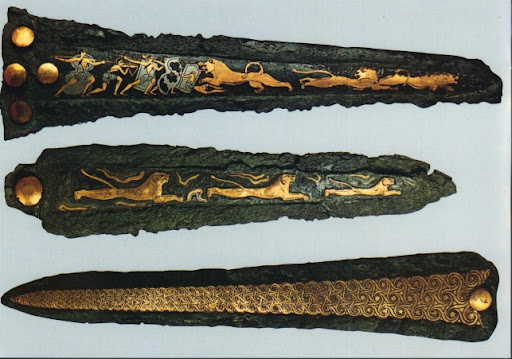
One of the hallmarks of Mycenaean culture was their military prowess, which was reflected in their sophisticated weaponry and armor. Mycenaean warriors were known for their skill in battle, wielding an array of formidable weapons, including swords, spears, and, of course, the bronze dagger.
The Significance of the Mycenaean Dagger
The Mycenaean dagger was more than just a functional weapon; it was a symbol of wealth, power, and the cultural sophistication of the Mycenaean elite. These daggers were not mass-produced, but rather were carefully crafted by skilled artisans, often using techniques that were highly advanced for the time.

The Mycenaean dagger was not only a practical tool for combat but also a canvas for artistic expression. The blades were often adorned with intricate designs, ranging from geometric patterns to elaborate depictions of animals, mythological creatures, and even scenes of battle. These decorative elements served to transform the dagger into a true work of art, reflecting the Mycenaeans’ deep appreciation for beauty and craftsmanship.
The Art of Mycenaean Dagger-Making
The manufacture of Mycenaean daggers was a complex and highly specialized process, involving the mastery of metalworking techniques that were at the forefront of Bronze Age technology. The Mycenaeans were renowned for their expertise in bronze casting, a skill that allowed them to create weapons and tools of exceptional quality and durability.
To create a Mycenaean dagger, the artisans would begin by smelting and refining copper and tin, the two primary components of bronze. The molten metal would then be poured into molds, often made of stone or clay, to create the basic blade shape. Once the blade was cast, the artisans would use a variety of tools and techniques to refine the surface, sharpen the edge, and add the intricate decorative elements.
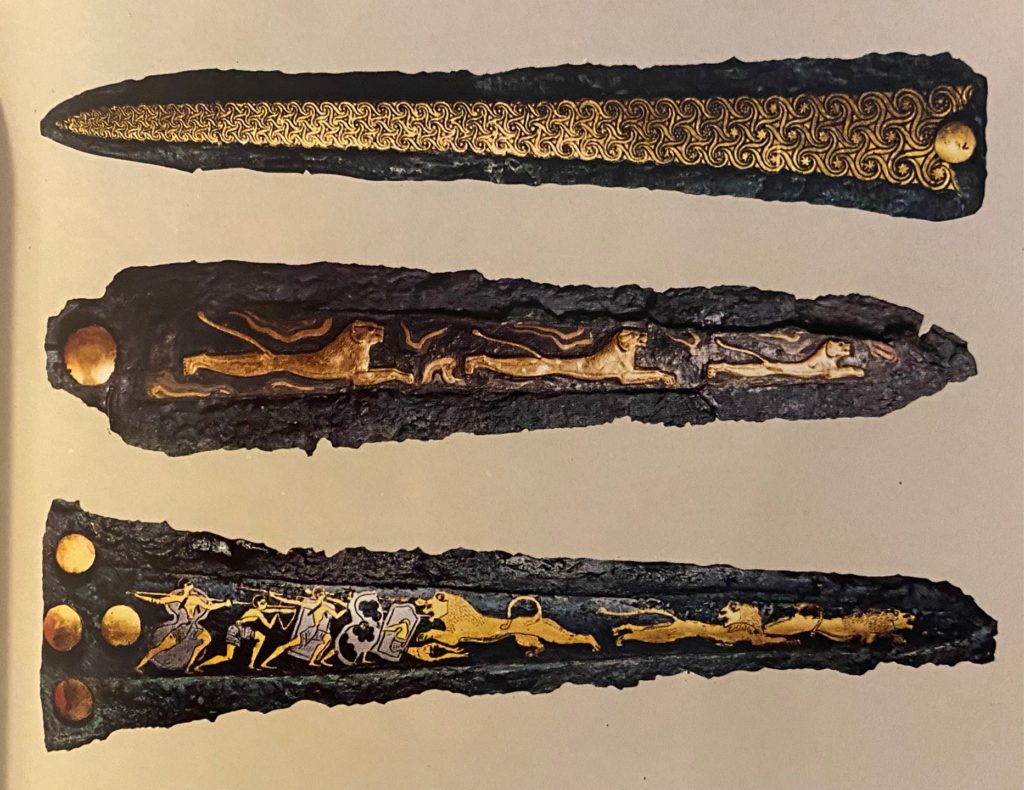
One of the most distinctive features of Mycenaean daggers was the use of inlaid precious metals, such as gold and silver, to create intricate patterns and designs. This technique, known as damascening, involved carefully embedding thin strips or wires of these precious metals into the bronze surface, creating a stunning visual effect.
The Mycenaeans also employed a technique known as repoussé, which involved hammering the bronze to create raised, three-dimensional designs on the surface of the blade. This allowed the artisans to create highly detailed and lifelike depictions of animals, mythological creatures, and even complex battle scenes.
Mycenaean Dagger Designs and Symbolism
The designs and motifs found on Mycenaean daggers were not merely decorative; they were imbued with deep cultural and symbolic meaning. These intricate patterns and images were carefully chosen to convey the power, status, and beliefs of the Mycenaean elite who commissioned and wielded these magnificent blades.
One of the most common motifs found on Mycenaean daggers was the depiction of lions, a symbol of strength, courage, and the might of the Mycenaean warrior. These majestic felines were often portrayed in dynamic, almost lifelike poses, their muscular forms and fierce expressions capturing the raw power and ferocity of the Mycenaean military.

Another prevalent design element was the inclusion of mythological creatures, such as griffins and sphinxes. These fantastical beasts were believed to possess supernatural powers and were often associated with the divine realm, lending an aura of mysticism and prestige to the daggers they adorned.
In addition to these symbolic motifs, Mycenaean daggers also featured intricate geometric patterns, which were a hallmark of the Mycenaean artistic tradition. These patterns, often arranged in repeating or symmetrical designs, were not only visually striking but also held deeper significance, representing the Mycenaeans’ sophisticated understanding of mathematics, engineering, and the natural world.
The Cultural and Social Significance of Mycenaean Daggers
Beyond their aesthetic appeal and technical mastery, Mycenaean daggers held a profound cultural and social significance within the Mycenaean society. These exquisite weapons were not merely tools of warfare but also symbols of power, status, and the cultural identity of the Mycenaean elite.
The possession of a Mycenaean dagger was a mark of distinction, signifying the wealth, prestige, and military prowess of its owner. These daggers were often presented as gifts to foreign dignitaries, cementing political alliances and demonstrating the Mycenaeans’ cultural and technological superiority.
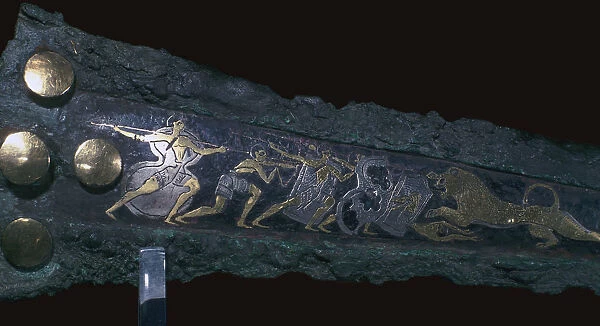
Within the Mycenaean social hierarchy, the ownership and use of these daggers were closely tied to the ruling class and the military aristocracy. The intricate designs and craftsmanship of these blades were a tangible expression of the Mycenaeans’ commitment to artistic excellence and their desire to project an image of power and sophistication to the wider world.
Moreover, Mycenaean daggers were not just functional weapons; they were also imbued with religious and spiritual significance. The depictions of mythological creatures and other symbolic motifs on the blades suggest that these daggers were seen as possessing a certain mystical or divine power, adding to their cultural and social importance within Mycenaean society.
The Legacy of Mycenaean Daggers
The enduring legacy of Mycenaean daggers can be seen in their lasting impact on the cultural and artistic traditions of the ancient Mediterranean world. These exquisite blades have inspired generations of artists, scholars, and enthusiasts, who have sought to understand and commemorate the Mycenaeans’ remarkable achievements in metalworking and design.
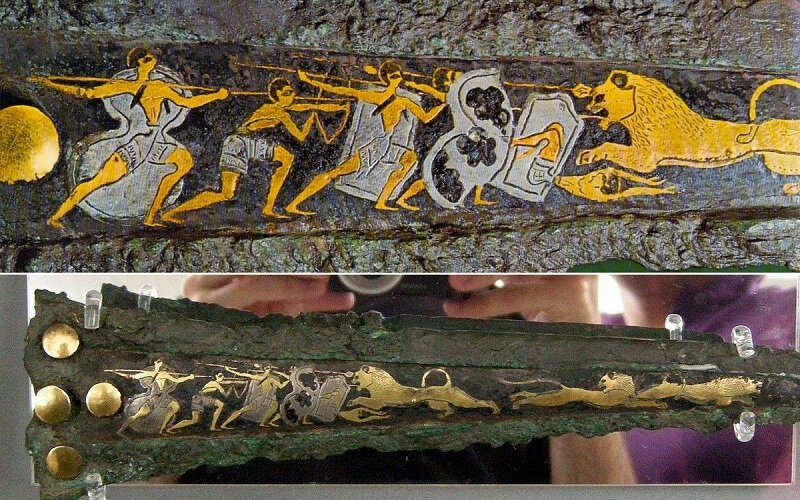
Today, Mycenaean daggers can be found in museums and private collections around the world, where they continue to captivate and inspire viewers with their breathtaking artistry and historical significance. These artifacts serve as a tangible link to the Mycenaean civilization, offering a glimpse into the sophisticated and technologically advanced culture that laid the foundations for the rise of classical Greek civilization.
Moreover, the legacy of Mycenaean daggers extends beyond their cultural and historical significance; they also continue to influence contemporary art, design, and popular culture. The striking imagery and intricate patterns found on these blades have been reinterpreted and reimagined in a variety of modern media, from fashion and jewelry to graphic design and literature.
Conclusion
The Mycenaean bronze dagger stands as a testament to the ingenuity, artistry, and cultural sophistication of the Mycenaean civilization. These exquisite weapons, forged from bronze and adorned with intricate designs, were not merely functional tools of warfare but also symbols of power, prestige, and the Mycenaeans’ deep appreciation for beauty and craftsmanship.
Through the study of Mycenaean daggers, we gain a deeper understanding of the Mycenaean civilization and its enduring legacy. These artifacts serve as a window into the past, allowing us to glimpse the technological prowess, artistic expression, and cultural values that defined one of the most influential civilizations in the ancient Mediterranean world.
As we continue to uncover and explore the rich history of the Mycenaeans, the Mycenaean dagger remains a captivating and enduring symbol of their remarkable achievements. From the grand palaces of Mycenae to the bustling urban centers of the Peloponnese, the bronze legacy of the Mycenaeans lives on, inspiring and captivating us with its timeless artistry and enduring cultural significance.

